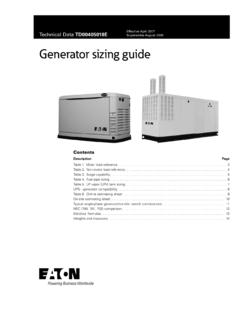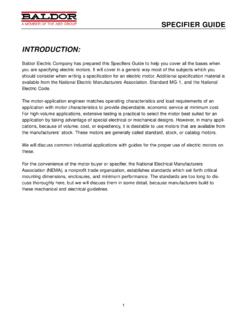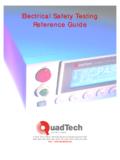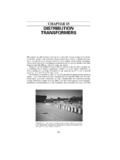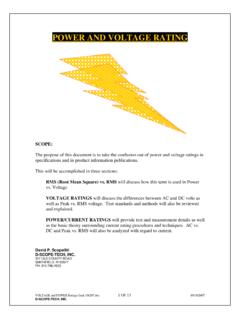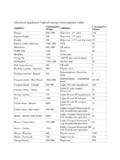Transcription of Fuse Selection Guide - OptiFuse
1 OptiFuse - Rev A 01/2010 - Page 1/9 fuse Selection Guide Although care is taken to properly design electrical and electronic circuits; overcurrents in the form of short-circuits and overload can occur. The sole purpose of fuses and circuit breakers is to protect personnel and/or equipment from serious harm when an overcurrent condition arises. This Guide is intended to help create a better understanding the various parameters of overcurrent protection and the proper application of circuit protective devices. This Guide creates a basic understanding of overcurrent principles and applications but is not intended to supplant sound engineering principles or replace specific application testing. Overcurrents An overcurrent is a condition which exists in an electrical circuit when the normal load current is exceeded.
2 The two basic forms of an overcurrent are overloads and short circuits. Fuses and circuits breakers primary role in a circuit is to protect personnel and equipment when dangerous overcurrents do happen. Short Circuit A short-circuit is an overcurrent condition where an abnormal, low-resistance, circuit path is introduced into the circuit. This low-resistance path bypasses the normal load and can create extremely high currents (up to 1000x the normal current under some conditions). Under normal conditions a typical circuit may be described by Ohm s Law as follows: When a short circuit occurs, a low-resistive, abnormal path is created which will cause the circuit current to increase as the circuit resistance is decreased. The current when a short circuit is introduced can exceed 1000 times the normal current of the circuit.
3 The circuit diagram of a short circuit is shown below: OptiFuse - Rev A 01/2010 - Page 2/9 Over Load An overload is an overcurrent condition where the current exceeds the normal full load-capacity of the circuit but where no fault condition (short-circuit) is present. A momentary overload condition (also known as in-rush currents) may also occur when a circuit is first initialized due to capacitor charging and/or motor-startup. A over load circuit diagram is shown below: In order to select the proper protective device, the following parameters and criteria need to be considered: 1. What is the normal operating current of the circuit? 2. What is the operating voltage? 3. Is the circuit AC or DC? 4. What is the operating ambient temperature?
4 5. What is the available short-circuit current? 6. What is the maximum allowable I t? OptiFuse - Rev A 01/2010 - Page 3/9 7. Are there in-rush currents available? 8. Is the protective device being used for short-circuit protection, over-load protection, or both? 9. What are the physical size limitations? 10. Is the PCB surface mount or thru-hole? 11. Does the fuse need to be "field-replaceable"? 12. Is resettability an issue? 13. What safety agency approvals are needed? 14. How will I mount the device? 15. What are the cost considerations? What is the normal operating current of the circuit? In order to select the right amperage of the fuse , you first need to know the full-load steady-state current of the circuit at an ambient temperature of 25 C (68 F).
5 Once the current value is determined, then a fuse rating should be selected as to be 135% of this value (taken to the next standard value). For example, if the normal steady-state current is calculated to be 10 amps, then a 15A fuse rating should be selected [10 amps x 135% = amps, the next larger standard size is 15A]. It is important to note that if the fuse is intended to be used in an environment with possibly very high or low ambient temperatures, then the nominal fuse current would need to be sized significantly higher or lower (see ambient temperature below). What is the operating voltage? The basic rule of thumb is that the voltage rating of the fuse must always higher than the voltage rating of the circuit that it is protecting. For example, if the circuit voltage is 24 volts, then the fuse voltage rating must be higher than 24 volts ( can be 250 so long as it s higher than the circuit voltage).
6 Is the circuit AC or DC? There exist two distinct types of circuits AC (alternating current) and DC (direct current). AC power is what you will typically find in your home from the electrical utility. AC power is created primarily by moving machines such as generators and delivered through the electric grid. DC power is typically used in electronic and automotive applications. DC power generally is created via a chemical reaction (as batteries and solar cells) or converted AC power through the use of AC to DC power supplies. OptiFuse - Rev A 01/2010 - Page 4/9 With AC power , the current and voltage oscillate back and forth. This oscillation helps the fuse to clear quickly. DC power on the other hand doesn t oscillate so the fuse must find other means to clear itself when opening.
7 Because of these differences, some fuses are designed specifically to be used in DC applications (such as automotive fuses). Some AC rated fuses may be used in DC applications, however there may be a voltage de-rating in these cases. What is the operating ambient temperature? Ambient temperature is a fancy way of saying the outside air surrounding the fuse . Normally, the fuses are tested in "laboratory conditions" by the safety agencies such as UL and CSA. The lab conditions are almost always set at 25 C or 77 F. Unfortunately, most real world conditions are not those found in a laboratory. Fuses are heat sensitive devices meaning that it takes heat (via the overcurrent) in order to melt the fuse element inside the fuse . The more faster it takes to melt the fuse less longer it takes to melt the fuse element.
8 If a fuse will be subjected to a higher temperature than 25 C, then the fuse amperage will need to be increased as to compensate for the higher temperature (to avoid "nuisance tripping"). Likewise, if the fuse will be used at a lower temperature, then the fuse amperage needs to be lowered (or else it might never open). The rule of thumb is that for every 20 C higher or lower in temperature, the fuse should be re-rated higher or lower 10-15%. An example of a fuse re-rating when higher ambient temperatures are present: Normal full-load current: 1 Amp Normal fuse sizing: Amps (135% of full load current taken to the next higher standard rating) Ambient Temperature: 65 C Re-rating: Re-rating: 2 Amps (130% of normal fuse rating) Conversely, when a fuse is intended to be used in extreme low temperature conditions, the fuse must have a lower rating than that in normal conditions.
9 An example of the fuse re-rating when lower ambient temperatures are present: Normal full-load current: 1 Amp Normal fuse sizing: Amps (135% of full load current taken to the next higher standard rating) Ambient Temperature: -15 C Re-rating: Amps (70% of normal fuse rating taken to the next higher standard fuse rating) OptiFuse - Rev A 01/2010 - Page 5/9 What is the available short-circuit current? The available short circuit current is the measured or calculated current that can be delivered to a circuit by a power source when a short circuit is present. This information is extremely important as an overcurrent protective device has only a finite ability to safely open a circuit when a fault condition occurs. Therefore the amount of fault current available is a critical piece of information in order to select the proper protective device.
10 The available short circuit calculation can be very complex and generally should be left to qualified engineers to calculate. These calculations are generally based on the following factors: How much short-circuit current is available from the utility? What is the resistance of the wiring from the utility to the piece of equipment where the fuse is installed? What is the internal resistance of the piece of equipment where the fuse is installed Once all of these factors are known, then the engineer can calculate the available short circuit current to the fuse . The fuse must be selected as to have a greater short circuit rating than what is available in the circuit (otherwise the fuse can explode and cause great harm to people and equipment!)

